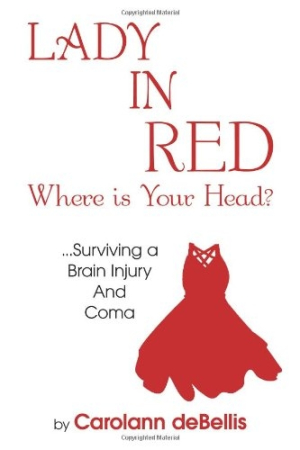Lady in Red
A brain injury and coma survivor speaks with raw honesty about the aftermath of an accident that tore her life apart.
In the blink of an eye, a person’s life can change. Carolann deBellis’ Lady in Red chronicles her life-changing car accident on the New Jersey Turnpike and what it was like to lose her sense of self.
Part memoir, part journal, the book includes family photographs, medical documents, drawings, and entries from a cousin’s journal. The author uses this hodgepodge of information to recreate her accident and its aftermath, showing readers how her life was broken apart and stitched back together.
There is a raw honesty to the sections where deBellis speaks directly to the reader. She does not shy away from the severity of her injuries or their impact on her life: how she became childlike, the loss of her job, and the end of her marriage. Similarly, deBellis is frank about her depression and her stay in a psychiatric ward. Her honesty sheds light on the harsh realities of brain injuries and how a life can be forever changed.
Her candid style is refreshing as it gives the reader unique insights into what it is like to deal with a brain injury. But her writing is sometimes jarring and hard to understand because the author bounces too quickly between topics—explaining the aftermath of a brain injury and coma and the loss of her job and husband.
Some of the more painful moments of the book occur when deBellis explains what it was like to lose a spouse. Particularly memorable is the author’s account of seeing her former husband on a date with someone else. It is at this point that both the reader and author realize that deBellis’ marriage and past life are truly over.
The timeline of events is sometimes difficult to understand. For example, deBellis begins by recounting the accident using medical documents, family photographs, and journal entries, but she quickly moves into talking about how she has always wanted write a book. The use of emoticons and crass language sometimes dilute the power of the author’s story.
Throughout, deBellis repeats key information with the last few sections all trying to conclude the memoir. Because, as deBellis writes, she “always has something else to say,” her book lacks a clear resolution or definitive ending when she keeps tacking on information.
Instead of grieving the past, deBellis celebrates her new vision of the world. After all, as she writes, “If your dreams die, you die.” Through positivity, counseling, and a supportive group of friends and family, deBellis is able to rebuild herself.
Reviewed by
Lisa Bower
Disclosure: This article is not an endorsement, but a review. The publisher of this book provided free copies of the book and paid a small fee to have their book reviewed by a professional reviewer. Foreword Reviews and Clarion Reviews make no guarantee that the publisher will receive a positive review. Foreword Magazine, Inc. is disclosing this in accordance with the Federal Trade Commission’s 16 CFR, Part 255.

